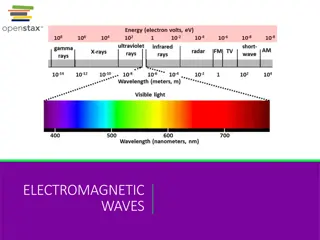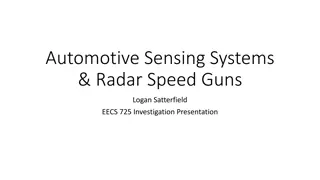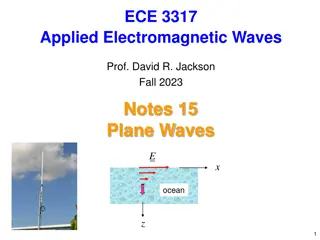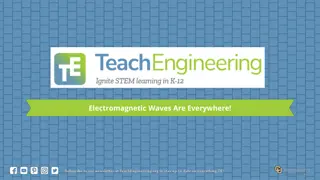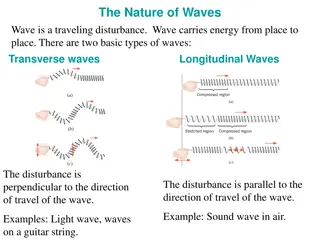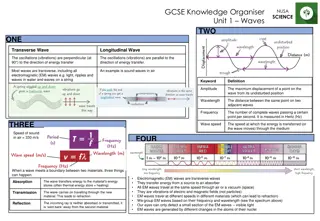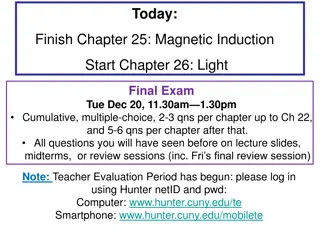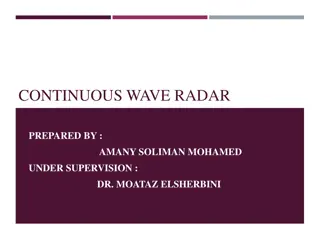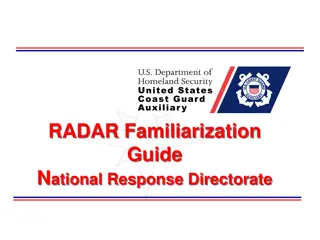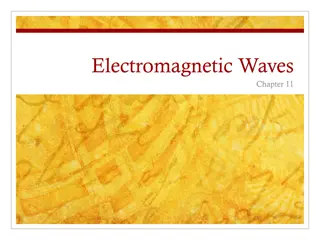Understanding Electromagnetic Waves and Radar Systems
Dive into the world of electromagnetic waves and radar systems with detailed explanations on wave basics, the electromagnetic spectrum, radar technology, and applications in geometry. Discover how radio waves are used in radar systems and the importance of electromagnetic energy in modern engineering and research.
Download Presentation

Please find below an Image/Link to download the presentation.
The content on the website is provided AS IS for your information and personal use only. It may not be sold, licensed, or shared on other websites without obtaining consent from the author. Download presentation by click this link. If you encounter any issues during the download, it is possible that the publisher has removed the file from their server.
E N D
Presentation Transcript
Catching the Perfect SAR Waves! Play Multimedia
Outline Wave Basics Electromagnetic Spectrum Tour Radio Detection And Ranging (Radar) SAR vs. ISAR Applications in Geometry Rise to the challenge
Wave Basics A wave is a continuous oscillation of energy in space time. The frequency of each wave is determined by measuring the number of repetitions an event occurred within a given time period then dividing the number of repetitions by the length of the time period. Frequency: f = # of repetitions/time The amplitude of a wave is maximum or minimum magnitude of an oscillation. The wave length is the distance at which the wave's pattern repeats. Waves are reflected, absorbed, diffracted, and scattered.
Wave Basics Wave Multimedia - Run NOW
Electromagnetic Spectrum Tour Engineers use all types of electromagnetic waves when working, researching, and playing! There are seven electromagnetic radiation waves: Radio, Microwaves, Infrared, Visible, Ultraviolet, X- rays, and Gamma-rays. The distinguishing characteristics among waves are: frequency, wave length, and radiation energy.
Electromagnetic Spectrum Tour Radar systems use radio waves why do think that is?? Radio waves do not require matter to transport energy; they can transport energy through a vacuum This makes it possible for satellites to use radars to detect objects outside the Earth s atmosphere Radio waves travel at constant speed through a vacuum called the speed of light. This is very useful when doing ranging calculations
Radio Detection And Ranging RADAR = Radio Detection And Ranging system The Radar system detects targets by reflected electromagnetic energy The Radar system is composed of a transmitter, receiver, antenna, and display. The transmitter produces rf (radio frequency) pulses of energy. The antenna propagates the produced rf pulses. The receiver captures, amplifies, and demodulates the backscatters. The Radar image is displayed on the indicator.
SAR vs. ISAR SAR = Synthetic Aperture Radar The beaming radar antenna is mounted onto a flying platform and sends radio waves to the ground targets. ISAR = Inverse Synthetic Aperture Radar The beaming radar antenna is stationary and sends radio waves to the moving target.
SAR vs. ISAR SAR Multimedia - Launch Interactive
Applications in Geometry Essentially Radar systems are distance calculating devices. We can use Pythagorean Theorem to calculate distances. Pythagorean Theorem: a + b = c where a, b are the short legs and c is the hypotenuse of a right triangle.
Rise to the Challenge Pretend you are an engineer working with NASA aviation. Under time and funding constraints, NASA has asked you to construct, calibrate, and evaluate their latest Radar system design. The functional prototype, the radar calibration results in graphical and tabular form, and the distance evaluation results are due in 4 days!
References Photo Dept. NASA Headquarters, 300 E. St. SW, Washington, DC 20546http://saturn.jpl.nasa.gov/photos/imagedetails/index.cfm?imageId=4399 "Radio Waves & Electromagnetic Fields." Teachers' Domain. 19 Apr. 2007. Web. 29 Jun. 2012. <http://www.teachersdomain.org/resource/hew06.sci.phys.energy.radiowaves/>. "The Electromagnetic Spectrum" NASA Mission: Science. 20 June. 2012. Web. Web. 29 Jun. 2012. <https://mynasadata.larc.nasa.gov/ElectroMag.html/> "Video Tour of Electromagnetic Specturm." NASA Mission: Science. 20 June. 2012. Web. Web. 29 Jun. 2012. http://missionscience.nasa.gov/ems/emsVideo_01intro.html/ "Imaging with Radar." Teachers' Domain. 29 Jan. 2004. Web. 29 Jun. 2012. <http://www.teachersdomain.org/resource/phy03.sci.phys.energy.radar/>.


